


THE PALACE OF VERSAILLES 1661 (C2)
Acknowledgements
Versailles: 1680s, by the French draughtsman Adam Pérelle (1640-1695) and the French engraver Israel Silvestre (1621-1691) – Metropolitan Museum of Art, New York. Vaux-le-Vicomte: 17th century engraving, artist unknown. Under construction: by the Flemish painter Adam Frans van der Meulen (1632-1690), 1669 – Royal Collection, UK. Hall of Mirrors: steel engraving, hand coloured, drawn by the British painter Frederick Mackenzie (c1788-1854), engraved by the British artist Charles Mottram (1807-1876), 1839. Gardens: 19th century, artist unknown. Interior: date and photographer unknown. Nymphe: date and photographer unknown.
Including:
Louis Le Vau, Jules
Hardouin-Mansart,
André Le Nôtre,
and Charles Le Brun

xxxxxWork began on the world-famous Palace of Versailles in 1661, and was completed in 1687. Built just 11 miles outside Paris, it was the seat of French government until 1789. The huge north and south wings were added in the 1680s. Its lavishly decorated interior includes the famous Galerie des Glaces. The magnificent formal gardens are noted for their Grand Canal and beautiful fountains, and contain two villas, Le Grand Trianon, designed for Louis XIV, and Le Petit Trianon, built for Louis XV. The major artists were the architect Louis Le Vau and his successor Jules Hardouin-Mansart, the landscape architect André Le Nôtre, and the painter and interior designer Charles Le Brun. As we shall see, the palace was destined to play an important part not only in French history, but also in the affairs of Europe.
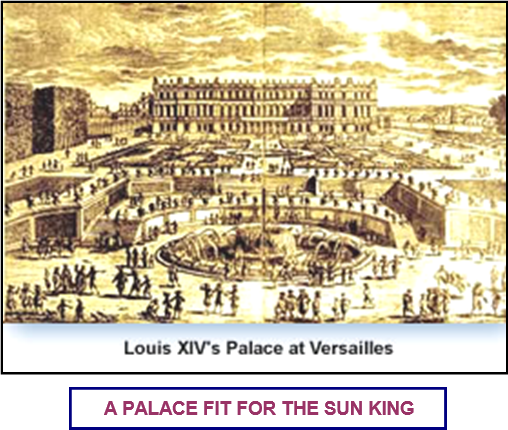 xxxxxWork began on the world-famous Palace of Versailles, 11 miles south-west of Paris, in 1661. Built by Louis XIV on the site of his father's hunting lodge, it was completed in 1687, and was the seat of the French government and “the living heart of France” from 1682 until the revolution of 1789. The huge north and south wings were added in the 1680s. The interior, made up of salons, royal apartments and extensive galleries, is lavishly decorated in the baroque style, and the furnishings are equally as sumptuous and ornate. The most spectacular gallery is the famous Galerie des Glaces, where the walls are almost entirely covered with vast mirrors. In front of the palace is a large courtyard containing statues of famous Frenchmen, and beyond lie the spectacular formal gardens.
xxxxxWork began on the world-famous Palace of Versailles, 11 miles south-west of Paris, in 1661. Built by Louis XIV on the site of his father's hunting lodge, it was completed in 1687, and was the seat of the French government and “the living heart of France” from 1682 until the revolution of 1789. The huge north and south wings were added in the 1680s. The interior, made up of salons, royal apartments and extensive galleries, is lavishly decorated in the baroque style, and the furnishings are equally as sumptuous and ornate. The most spectacular gallery is the famous Galerie des Glaces, where the walls are almost entirely covered with vast mirrors. In front of the palace is a large courtyard containing statues of famous Frenchmen, and beyond lie the spectacular formal gardens.
xxxxxThese vast gardens are formally laid out with trees, shrubs and works of sculpture, but there are a number of secluded groves. The major features are the Grand Canal - a mile in length -, the magnificent fountains, and the attractive Orangery. In the parkland north of the gardens are two royal villas or palaces. Le Grand Trianon was designed for Louis XIV, and Le Petit Trianon, the work of Jacques Gabriel, was built for Louis XV - and later became a favourite retreat of Marie Antoinette, wife of the ill-fated Louis XVI.
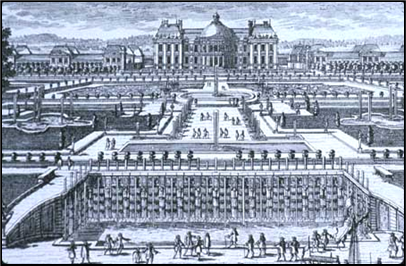 xxxxxThexartists who were appointed to oversee this work were the architect Louis Le Vau, the painter and interior designer Charles Le Brun, and the landscape architect André Le Nôtre. Louis XIV had seen the fruits of their work at the Chateau de Vaux-le-Vicomte (illustrated), the new, stately home of his highly ambitious finance minister Nicolas Fouquet - whose coat of arms bore the motto “To what heights may I not climb?” When, in 1661, Fouquet was conveniently sacked and charged with embezzlement - the king was obviously alarmed by his wealth and exalted position - these artists, and many others, were simply transferred to Versailles to begin work on the king’s own ambitious project. We are told that when Fouquet was eventually imprisoned, the best statues and trees in his grounds were also transferred to Versailles!
xxxxxThexartists who were appointed to oversee this work were the architect Louis Le Vau, the painter and interior designer Charles Le Brun, and the landscape architect André Le Nôtre. Louis XIV had seen the fruits of their work at the Chateau de Vaux-le-Vicomte (illustrated), the new, stately home of his highly ambitious finance minister Nicolas Fouquet - whose coat of arms bore the motto “To what heights may I not climb?” When, in 1661, Fouquet was conveniently sacked and charged with embezzlement - the king was obviously alarmed by his wealth and exalted position - these artists, and many others, were simply transferred to Versailles to begin work on the king’s own ambitious project. We are told that when Fouquet was eventually imprisoned, the best statues and trees in his grounds were also transferred to Versailles!
xxxxxAs we shall see, in the years to come, the palace was destined to play an important part not only in French history, but also in the affairs of Europe. When the American War of Independence finally came to an end, for example, the peace settlement was signed at Versailles in 1783. And it was on one of the tennis courts here that the "National Assembly" took the famous oath in June 1789, marking the beginning of the French Revolution. And in October of the same year an angry mob arrived from Paris and forced Louis XVI and Marie Antoinette to make their fateful journey to the capital. During the Franco-Prussian War of 1870-71, the Germans set up their headquarters in the town, and William I was proclaimed emperor of Germany in the Hall of Mirrors in January 1871, whilst his troops were laying siege to Paris. It became the meeting place of the French National Assembly during the Third Republic and, at the conclusion of the First World War, the peace treaty between the great powers was signed in the Hall of Mirrors in 1919. More recently, it has provided the venue for meetings of Western heads of government.
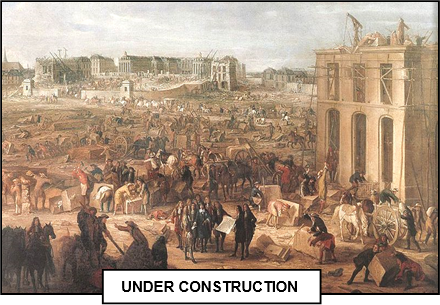 xxxxxThe French architect Louis Le Vau (1612-70) was one of the principal designers of the palace, and came to prominence during his work on the Chateau de Vaux-le-Vicomte, the new home of Louis XIV's finance minister, Nicholas Fouquet. The grandeur and opulence of this stately building - which included a huge oval salon - so impressed the king that he put Le Vau to work on his own ambitious project - a palace befitting the all-powerful Sun King of France. He began his task in 1669 and, being responsible for the enlargement of an existing chateau and the creation of a garden facade, produced a design which was monumental in scale, and combined classical symmetry with baroque grandeur. He carried this style into the interior with his Ambassador's Staircase, but this was destroyed in 1752.
xxxxxThe French architect Louis Le Vau (1612-70) was one of the principal designers of the palace, and came to prominence during his work on the Chateau de Vaux-le-Vicomte, the new home of Louis XIV's finance minister, Nicholas Fouquet. The grandeur and opulence of this stately building - which included a huge oval salon - so impressed the king that he put Le Vau to work on his own ambitious project - a palace befitting the all-powerful Sun King of France. He began his task in 1669 and, being responsible for the enlargement of an existing chateau and the creation of a garden facade, produced a design which was monumental in scale, and combined classical symmetry with baroque grandeur. He carried this style into the interior with his Ambassador's Staircase, but this was destroyed in 1752.
xxxxxLouis Le Vau was trained by his father, a stone-mason, and early in his career designed a number of townhouses in Paris (then called hôtels) for the new class of rich bankers and merchants. During this period his most notable work was the Hôtel Lambert, completed in 1644. Later works in the capital included the College of the Four Nations for Cardinal Mazarin, and the completion of the Louvre Palace.
xxxxxThe French architect Louis Le Vau (1612-70) was one of the principal designers of the Palace of Versailles. He began his work in 1669 and produced a design which was monumental in scale, and combined classical symmetry with baroque grandeur. In Paris he built a number of luxurious townhouses, designed the College of the Four Nations for Cardinal Mazarin, and completed the work on the Louvre Palace. He came to prominence while working on the Chateau de Vaux-le-Vicomte for the finance minister, Nicholas Fouquet. Louis XIV saw his design and put him to work at Versailles.
xxxxxLe Vau was succeeded by Jules Hardouin-Mansart (1646-1708). He more than trebled the size of the palace. In addition to the vast baroque extensions to the south and north, where he maintained the classical symmetry and grandeur of scale, he designed the Royal Chapel and the Orangery. He also created the imposing Hall of Mirrors, completed in 1684, a major feature of the interior (illustrated below), and built Le Grand Trianon in the Palace grounds in 1688.
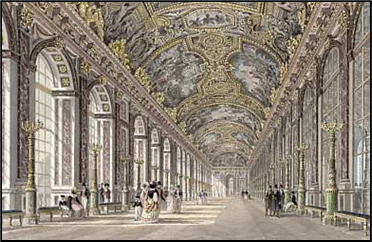
xxxxxMuch of his work - which included town palaces, municipal buildings, churches and public squares - was carried out in Paris. Outstanding among these are the octagonal La Place Vendôme, La Place des Victoires, and his masterpiece, the magnificent dome of the Church of Les Invalides, begun in 1676 and not completed until two years before his death. In 1843 a circular crypt was made directly beneath this dome to house the elaborate tomb of Napoleon Bonaparte.
xxxxxIncidentally, Hardouin-Mansart's great uncle, François Mansart (1598-1666), a highly successful architect in the first half of the 17th century, was the man who gave his name to the "mansard roof", a high-pitched, two-sloped roof that was pleasing to the eye and gave much greater attic space.
xxxxxThe architect Le Vau was succeeded by Jules Hardouin-Mansart (1646-1708). He added the vast Baroque extensions either side of the palace, and designed the Royal Chapel and the imposing Hall of Mirrors. In the grounds he built the Orangery and Le Grand Trianon. However, he spent much of his time in Paris, where his work included palaces, municipal buildings, churches and public squares. He was responsible, for example, for La Place Vendôme, La Place des Victoires, and the magnificent dome of the Church of Les Invalides, beneath which the tomb of Napoleon Bonaparte was built in 1843.
C2-1660-1685-C2-1660-1685 -C2-1660-1685-C2-1660-1685-C2-1660-1685-C2-1660-1685-C2
xxxxxThe formal gardens at the Palace of Versailles were the work of the French landscape artist André Le Nôtre (1613-1700). He transformed 15,000 acres of swamp into gardens of awe-inspiring grandeur, filled with immaculate flower beds, long vistas, soaring fountains and classical statues. His style set the pattern of landscape gardening throughout Europe. He began his successful career when he succeeded his father as master gardener at the Tuileries, the formal gardens in Paris. He visited London in 1661, and may well have been responsible for the design of St. James’ Park.
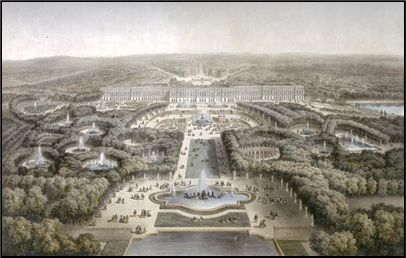 xxxxxThe gardens, which add so much to the setting and grandeur of the palace itself, were the work of the French landscape artist André Le Nôtre (1613-1700). He transformed 15,000 acres of swampy land into gardens of calm but awe-inspiring grandeur. Laid out in strict, formal arrangement, and stretching almost as far as the eye can see, they overwhelm the senses by their long vistas of neatly clipped trees, geometric terraces, and immaculate flower beds. And to this spectacle of symmetry, order and harmony is added the dignified splendour created by soaring fountains, classical statues, and large ornamental urns. Nor does the vista end there. Beyond the gardens stretch wide lawns against a background of shrubs and woodland. It is little wonder that for the next hundred years or so Le Nôtre set the pattern of landscape gardening for Europe's royalty, nobility and gentry.
xxxxxThe gardens, which add so much to the setting and grandeur of the palace itself, were the work of the French landscape artist André Le Nôtre (1613-1700). He transformed 15,000 acres of swampy land into gardens of calm but awe-inspiring grandeur. Laid out in strict, formal arrangement, and stretching almost as far as the eye can see, they overwhelm the senses by their long vistas of neatly clipped trees, geometric terraces, and immaculate flower beds. And to this spectacle of symmetry, order and harmony is added the dignified splendour created by soaring fountains, classical statues, and large ornamental urns. Nor does the vista end there. Beyond the gardens stretch wide lawns against a background of shrubs and woodland. It is little wonder that for the next hundred years or so Le Nôtre set the pattern of landscape gardening for Europe's royalty, nobility and gentry.
xxxxxLe Nôtre began his highly successful career when he succeeded his father as master gardener to Louis XIII at the Tuileries - gardens in Paris and so named because of the tile factories that once stood on the site. Here he extended the central avenue deep into the surrounding countryside, tracing a line which was eventually to end up as the Champs Elysees! He later became responsible for all the major royal gardens. Like Le Vau, he came to the notice of Louis XIV whilst developing the formal gardens at the Chateau de Vaux-le-Vicomte. He visited London in 1662 and there is a suggestion that, while in the capital, he was responsible for the design of St. James' Park.
xxxxxThe French interior designer Charles Le Brun (1619-90) studied under the French classical artist Nicolas Poussin. He was appointed principal painter to Louis XIV in 1662, and was made responsible for the furniture, carpets and tapestries at the Palace of Versailles. The following year he became the first director of the Gobelins tapestry and furniture factory, and was able to call on the services of men like the brilliant cabinet maker André Charles Boulle. The splendour and luxuriant magnificence of Le Brun’s designs - a mixture of ornate baroque and classical grandeur - won him fame and fortune, and he gained the king’s favour by his series of tapestries depicting some of the achievements of his reign.
xxxxxCharles Le Brun (1619-1690) was the son of a master sculptor. After some artistic tuition at home, he studied in Italy for four years under the French classical artist Nicolas Poussin. By his influence, and that of contemporary Italian artists, he began to develop the French classical style associated with the reign of Louis XIV, a sumptuous mixture of ornate baroque and classical grandeur. He returned to Paris in 1646 and, after painting frescoes in Fouquet's impressive villa and in the Louvre, was appointed principal painter to the king in 1662. As a consequence, he was put in charge of the design work at the palace of Versailles, responsible for all the furniture, carpets and tapestries.
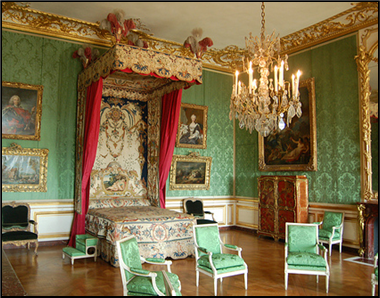 xxxxxThe following year he was made the first director of the Gobelins tapestry and furniture factory (bought by the king in 1662), and was thus able to call on the services of a team of top-class artisans, including goldsmiths, bronze workers, and the brilliant cabinet maker André Charles Boulle. They manufactured all the royal furnishings. The grandeur and luxuriant magnificence of Le Brun's designs - opulent marble, intricate plasterwork, and high painted ceilings - can best be seen in his decoration and furnishing of the Hall of Mirrors and of the adjoining rooms depicting war and peace. And he also had a hand in the design of the gardens and the choice of statues displayed there.
xxxxxThe following year he was made the first director of the Gobelins tapestry and furniture factory (bought by the king in 1662), and was thus able to call on the services of a team of top-class artisans, including goldsmiths, bronze workers, and the brilliant cabinet maker André Charles Boulle. They manufactured all the royal furnishings. The grandeur and luxuriant magnificence of Le Brun's designs - opulent marble, intricate plasterwork, and high painted ceilings - can best be seen in his decoration and furnishing of the Hall of Mirrors and of the adjoining rooms depicting war and peace. And he also had a hand in the design of the gardens and the choice of statues displayed there.
xxxxxEarlier, in 1648, Le Brun was one of the founders of the French Academy of Painting and Sculpture, and became its director in 1663. A man of great wealth and prestige, he gained the king's favour with a series of paintings on the life of Alexander the Great, and a series of tapestries depicting some of the achievements of the king himself.
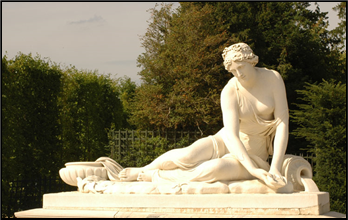
xxxxxIncidentally, inxadvising on the choice of statutory in the gardens at Versailles, Le Brun collaborated with two outstanding French sculptors of this period, both of whom tempered baroque richness with classical restraint. François Girardon (1628-1715) produced a number of fine works, including Apollo Tended by the Nymphs and Bath of the Nymphs. He is also remembered for his tomb of Cardinal Richelieu in the Chapel of the Sorbonne, Paris. Antoine Coysevox (1640-1720), apart from his statutory in the grounds of the palace, such as Renown, Mercury, and Nymphe à la Coquille (illustrated), gained a reputation for his portrait busts, and designed the tombs for the finance minister Jean Baptiste Colbert, and Cardinal Mazarin. ……
xxxxx…… In 1689 the original silver furniture in the palace was melted down to help pay for Louis XIV's costly wars!







 xxxxxWork began on the world-
xxxxxWork began on the world- xxxxxThexartists who were appointed to oversee this work were the architect Louis Le Vau, the painter and interior designer Charles Le Brun, and the landscape architect André Le Nôtre. Louis XIV had seen the fruits of their work at the Chateau de Vaux-
xxxxxThexartists who were appointed to oversee this work were the architect Louis Le Vau, the painter and interior designer Charles Le Brun, and the landscape architect André Le Nôtre. Louis XIV had seen the fruits of their work at the Chateau de Vaux- xxxxxThe French architect Louis Le Vau (1612-
xxxxxThe French architect Louis Le Vau (1612-
 xxxxxThe gardens, which add so much to the setting and grandeur of the palace itself, were the work of the French landscape artist André Le Nôtre (1613-
xxxxxThe gardens, which add so much to the setting and grandeur of the palace itself, were the work of the French landscape artist André Le Nôtre (1613- xxxxxThe following year he was made the first director of the Gobelins tapestry and furniture factory (bought by the king in 1662), and was thus able to call on the services of a team of top-
xxxxxThe following year he was made the first director of the Gobelins tapestry and furniture factory (bought by the king in 1662), and was thus able to call on the services of a team of top-


